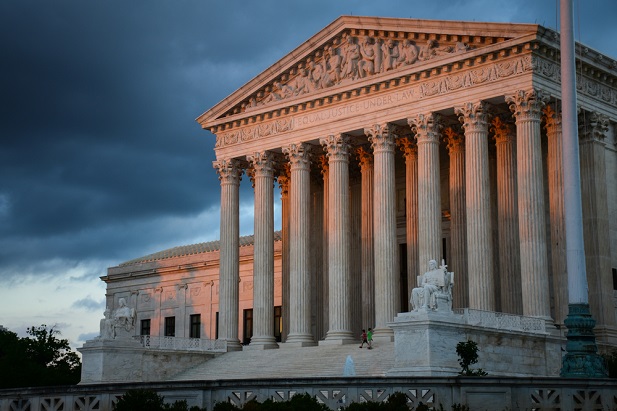 The USC403(b) case had the potential to dramatically impact the growingbody of claims against sponsors of retirement plans. (Photo:Shutterstock)
The USC403(b) case had the potential to dramatically impact the growingbody of claims against sponsors of retirement plans. (Photo:Shutterstock)
The Supreme Court will not review a 403(b) excessive fee lawsuit brought againstfiduciaries of the University of Southern California's retirementplan, according to a document from the High Court released thisweek.
|Last November, USC petitioned the Supreme Court to review adecision from the Ninth Circuit Court of Appeals. In 2016, Munro v.USC was filed in U.S. District Court for the Central District ofCalifornia. Plaintiffs alleged millions in plan assets were lost toexcessive recordkeeping fees, expensive retail investmentofferings, and onerous surrender charges on annuities offered inthe plan.
|USC petitioned the District Court to compel arbitration on individual claims against theplan based on arbitration agreements participants in the plansigned upon accepting jobs at USC.
|In March of 2017, the District Court denied USC's motion on thegrounds that the arbitration agreements did not extend to claimsagainst the retirement plan because the agreements were signed onbehalf of employees, and not on behalf of the 403(b) plan. Lastyear, the Ninth Circuit unanimously upheld the decision onappeal.
|Related: Are class-action waivers in the future of ERISAplans?
|The case had the potential to dramatically impact the growing body of claims against sponsors ofretirement plans brought under the Employee Retirement IncomeSecurity Act.
|“Benefits lawyers have been struggling with this question forsome time,” Ian Morrison, co-chair of the ERISA & EmployeeBenefits Litigation Practice Group at Seyfarth Shaw, toldBenefitsPRO in an interview. “Can you force arbitration in ERSIAclaims? People have been trying to push arbitration to eliminateclass-action exposure.”
|In some contexts, courts have found that ERISA claims arearbitrable. But the question of who is bringing claims—anindividual or a plan—has not been fully resolved by courts,Morrison said.
|“The fundamental question when seeking to compel arbitration isdid the plaintiff agree to arbitrate claims. The USC claim reallyturns on the issue of whose claim this is,” explained Morrison.
|Under ERISA case law, the question of who is suing—a person or aplan—remains murky. The Ninth Circuit's decision was the first toaddress the enforceability of general employment arbitration agreements inthe ERISA context. The Supreme Court agreeing to review thequestion would have been “a big step forward,” said Morrison.
|The plaintiffs' original claims will now return to the DistrictCourt.
|Still waiting on Putnam request for review
Putnam Investments has also requested the Supreme Court review adecision from the First Circuit Court of Appeals.
|In Brotherston v. Putnam Investments, former Putnam employeesalleged its 401(k) plan fiduciaries breached ERISA's duty ofprudence by offering the firm's proprietary funds, most of whichwere actively managed.
|In 2017, the U.S. District Court for the District ofMassachusetts ruled in favor of Putnam on the grounds that theplaintiffs failed to show a loss from investing in the proprietaryfunds.
|But in October of 2018, the First Circuit partially overturnedthe lower court. At issue in the petition filed with the SupremeCourt is whether the plaintiffs or defendants in ERISA claims bearthe burden of proving whether investment losses resulted in lossesto 401(k) participants.
|As was noted in the First Circuit's decision, appellate courtsare split on which party is responsible for proving loss causationin ERISA lawsuits. The First Circuit joined with the Fourth, Fifth,and Eighth Circuits in saying the burden falls on defendantsponsors of plans.
|This week, an amicus brief was filed by the U.S. Chamber ofCommerce, SIFMA, the American Benefits Council, the ERISA IndustryCommittee, and the American Retirement Association on behalf ofPutnam.
|By shifting the burden of disproving losses to Putnam, the FirstCircuit compounded the already expensive and difficult process ofdefending ERISA lawsuits, the amicus brief argues.
|“What counts as a loss and whether fiduciaries will face theburden of disproving loss causation now turn on where they aresued,” the brief says, referring to the circuit split.
|If courts can shift the burden of disproving plaintiffs' claimsto Putnam and other plan sponsors, “plaintiffs do not even need totry to show that the fiduciaries' chosen investments wereobjectively imprudent and caused losses. Instead, they can simplypoint to perceived problems in the fiduciaries' process, comparethe portfolio's performance to their favorite index fund, and thentake potshots at the fiduciaries' attempt to disprove causation,”according to the brief.
|READ MORE:
|Why 403(b) plan sponsors are in a legalhotseat
||Complete your profile to continue reading and get FREE access to BenefitsPRO, part of your ALM digital membership.
Your access to unlimited BenefitsPRO content isn’t changing.
Once you are an ALM digital member, you’ll receive:
- Critical BenefitsPRO information including cutting edge post-reform success strategies, access to educational webcasts and videos, resources from industry leaders, and informative Newsletters.
- Exclusive discounts on ALM, BenefitsPRO magazine and BenefitsPRO.com events
- Access to other award-winning ALM websites including ThinkAdvisor.com and Law.com
Already have an account? Sign In
© 2024 ALM Global, LLC, All Rights Reserved. Request academic re-use from www.copyright.com. All other uses, submit a request to [email protected]. For more information visit Asset & Logo Licensing.








